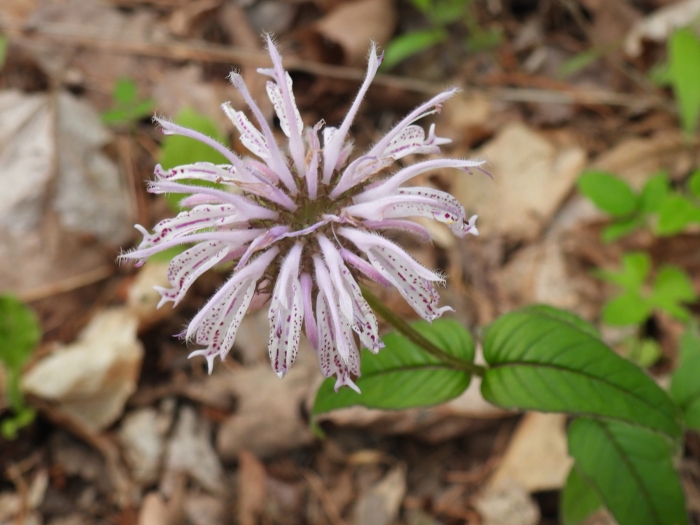Eastern Beebalm
(Monarda bradburiana)
Eastern Beebalm (Monarda bradburiana)
/
/

Judy Ulrich
CC BY 4.0
Image By:
Judy Ulrich
Recorded By:
Copyright:
CC BY 4.0
Copyright Notice:
Photo by: Judy Ulrich | License Type: CC BY 4.0 | License URL: http://creativecommons.org/licenses/by/4.0/ | Rights Holder: Judy Ulrich | Publisher: iNaturalist | Date Created: 2021-05-16T16:02:46-07:00 |






































Estimated Native Range
Summary
Monarda bradburiana, commonly known as Eastern Beebalm, is a deciduous perennial herb native to the open woodlands and prairies of the Central United States. It typically grows to a height of 1 to 2 feet (30 to 60 cm) and features distinctive flowerheads that are initially cone-shaped, becoming flatter as they mature. The flowers, blooming in late spring to early summer, are composed of tubular, hairy calyces with five pointed lobes and florets that are white or pink, curved, and about 1 inch (2.5 cm) long. The lower lip of each floret is slightly wider and speckled with purple, adding to the plant’s ornamental value.
Eastern Beebalm is valued for its aromatic foliage and showy flowers, which are highly attractive to pollinators such as bumblebees, butterflies, hummingbird moths, beeflies, and hummingbirds. It is often used in native plant gardens, borders, and as part of pollinator-friendly landscaping. This plant thrives in full sun to part shade and prefers soils with medium drainage. While it is drought-tolerant once established, it benefits from occasional watering during prolonged dry spells. Eastern Beebalm can spread by rhizomes, making it suitable for naturalistic plantings but may require control in smaller garden settings. It is also susceptible to powdery mildew, especially in humid conditions or when airflow is restricted.CC BY-SA 4.0
Eastern Beebalm is valued for its aromatic foliage and showy flowers, which are highly attractive to pollinators such as bumblebees, butterflies, hummingbird moths, beeflies, and hummingbirds. It is often used in native plant gardens, borders, and as part of pollinator-friendly landscaping. This plant thrives in full sun to part shade and prefers soils with medium drainage. While it is drought-tolerant once established, it benefits from occasional watering during prolonged dry spells. Eastern Beebalm can spread by rhizomes, making it suitable for naturalistic plantings but may require control in smaller garden settings. It is also susceptible to powdery mildew, especially in humid conditions or when airflow is restricted.CC BY-SA 4.0
Plant Description
- Plant Type: Herb
- Height: 1-2 feet
- Width: 1-2 feet
- Growth Rate: Moderate
- Flower Color: Pink, White, Purple
- Flowering Season: Spring, Summer
- Leaf Retention: Deciduous
Growth Requirements
- Sun: Full Sun, Part Shade
- Water: Low, Medium
- Drainage: Medium
Common Uses
Bee Garden, Bird Garden, Border Plant, Butterfly Garden, Deer Resistant, Drought Tolerant, Edible*Disclaimer: Easyscape's listed plant edibility is for informational use. Always verify the safety and proper identification of any plant before consumption., Fragrant, Groundcover, Hummingbird Garden, Low Maintenance, Rabbit Resistant, Showy Flowers, Street Planting
Natural Habitat
Native to open woodlands and prairies of the Central United States
Other Names
Common Names: Bradbury’s Beebalm, Wildbergamot Beebalm
Scientific Names: , Monarda bradburiana, Monarda villosa, Monarda amplexicaulis, Monarda rigida,
GBIF Accepted Name: Monarda bradburiana Beck